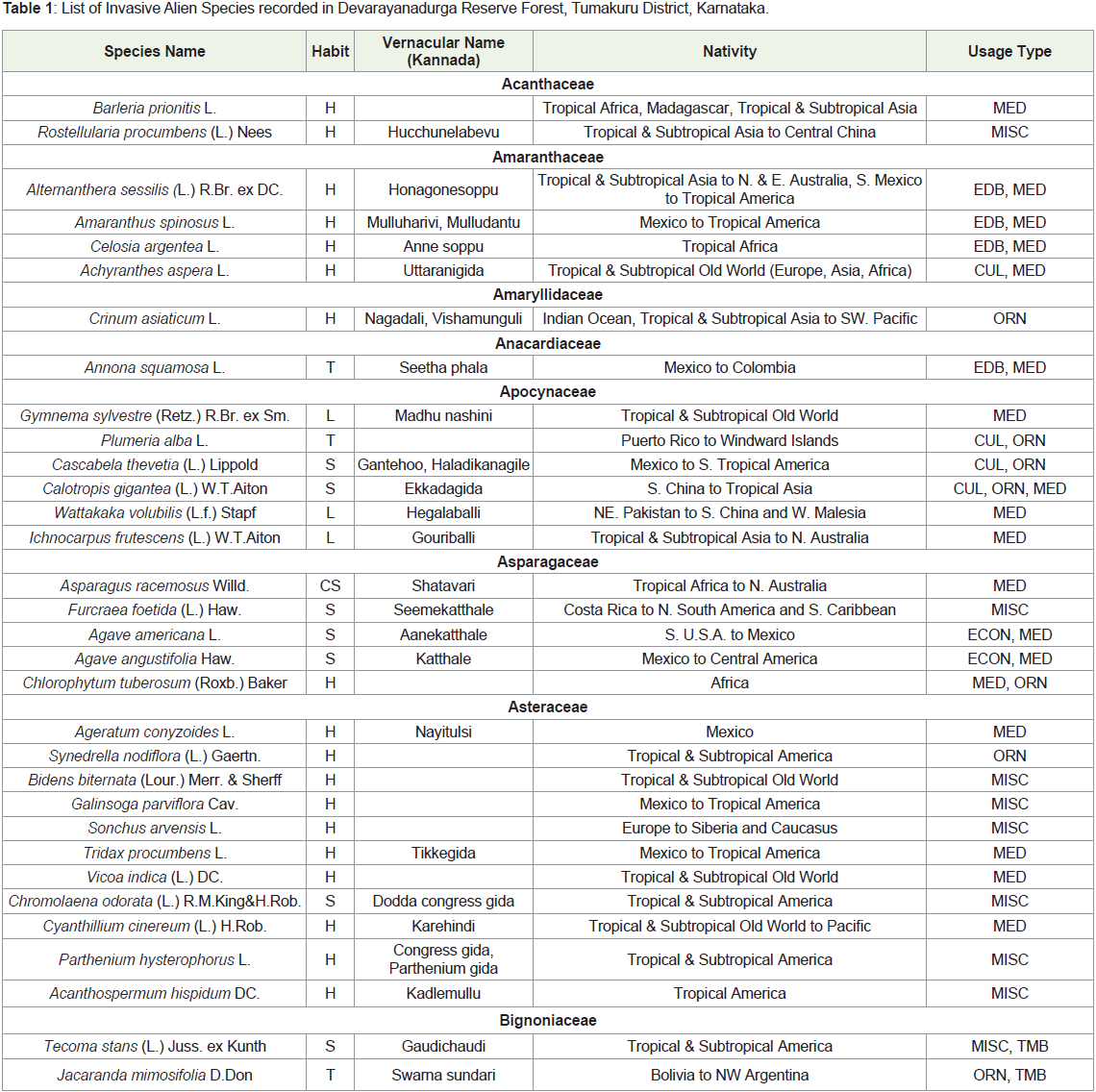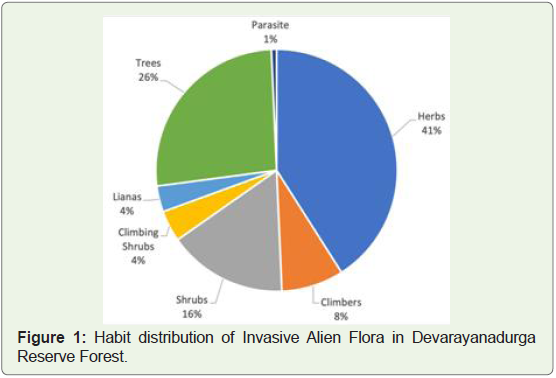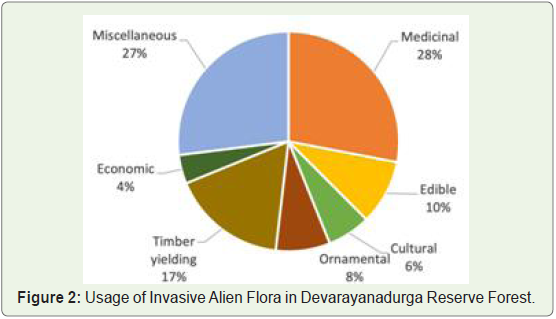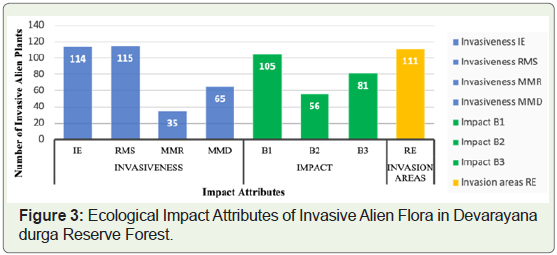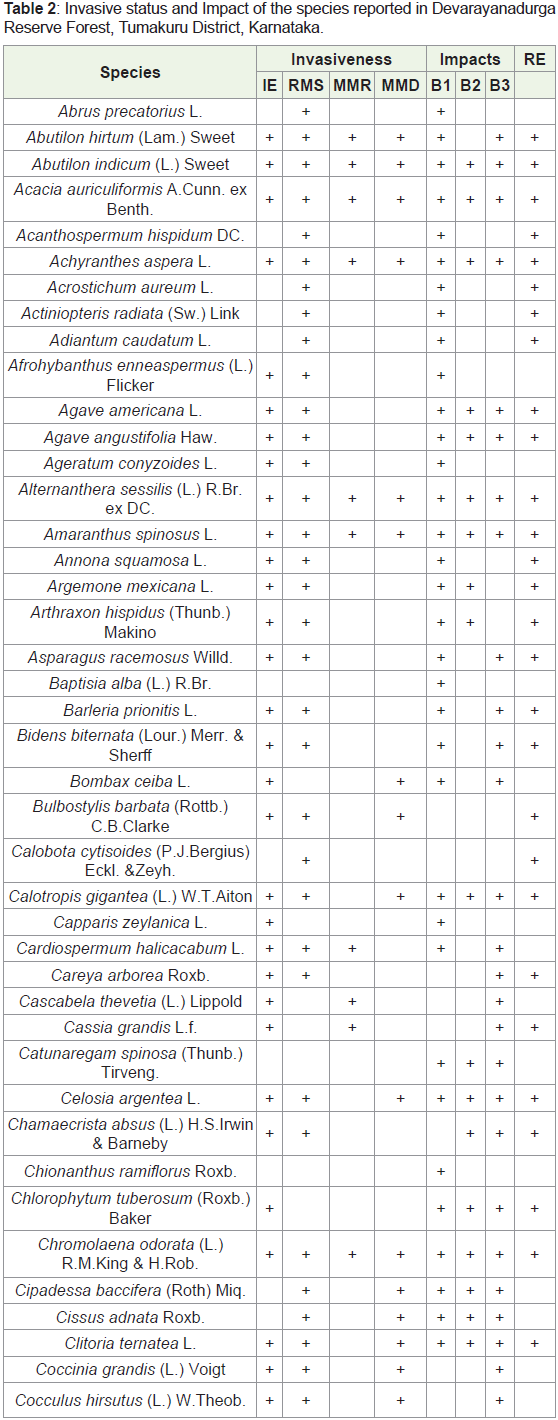Research Article
Ecological Impacts of Invasive Alien Flora in Devarayanadurga Reserve Forest, Tumakuru District, Karnataka
Mouna S* and Kotresha K
Floristic and Taxonomy Laboratory, Department of UG, PG & Research in Botany, Karnatak University’s, Karnatak Science
College, Dharwad - 580001, Karnataka, India
*Corresponding author: Mouna S, Floristic and Taxonomy Laboratory, Department of UG, PG & Research in Botany,
Karnatak University’s, Karnatak Science College, Dharwad - 580001, Karnataka, India; E-mail: mouna.sidd@gmail.
com
Copyright: © Mouna and Kotresha. 2022. This is an open access article distributed under the Creative Commons Attribution
License, which permits unrestricted use, distribution, and reproduction in any medium, provided the original work is properly cited.
Article Information: Submission:19/09/2022; Accepted: 20/10/2022; Published: 24/10/2022
Abstract
An alien plant also referred to as exotic, introduced, foreign, non-indigenous or non-native, is one that has been introduced by humans intentionally
or otherwise through human agency or accidentally from one region to another. Those naturalized aliens that become so successful as to spread in the
flora and displace native biota or threatens valued environmental, agricultural, or personal resources by the damage it causes are considered invasive.
Devarayanadurga Reserve Forest (DRF) in Tumakuru District is a tropical dry deciduous type, comparatively dense forest with predominant tree species. It is
known for harboring varieties of medicinal plants. During the present study a total of 144 Invasive Alien Species (IAS) belonging to 130 genera of 51 families
were recorded. Fabaceae is the dominating invasive family with 27 species followed by Asteraceae and Malvaceae with 11 and 8 species respectively.
105 IAS were reported to be affecting ecosystem functions and services, 56 IAS to be causing biodiversity loss and 81 IAS to be causing economic loss
and health hazards of either human or wildlife or both. 111 IAS shows continuous spread in DRF with range extension. IAS affects the ecosystem of the
region, the economy of the surroundings, habitat destruction, biodiversity loss, human health, and livelihood. Hence timely monitoring of the phenology and
distribution pattern studies of IAS should be undertaken to successfully eradicate them and re-establish native species.
Keywords
Alien species; Biodiversity; Invasive flora, Ecological impact, Tumakuru
Introduction
Invasive Alien Species (IAS) is one of the major threats to global
and local biodiversity. In forest ecosystems, the threats caused by
IAS include hybridization, transmission of diseases and species
competition [1]. An alien plant also referred to as exotic, introduced,
foreign, non-indigenous or nonnative, is one that has been introduced
by humans intentionally or otherwise through human agency or
accidentally from one region to another. An alien plant that has
escaped from its original ecosystem and is reproducing on its own in
the regional flora is considered a naturalized species. Those naturalized
aliens that become so successful as to spread in the flora and displace
native biota or threaten valued environmental, agricultural, or
personal resources by the damage it causes are considered invasive.
Monitoring is required in invasive species management to determine
the location and early detection of problematic species, whether a
species is likely to become a problem in an area, whether a species
is responding to management efforts and the impact of alien plant
control methods on native species. Monitoring of invasion can be
done through qualitative approach like species inventory (seasonally)
and quantitative approach using phytosociological methods and
mapping by ground-based methods (Via map overlays or GPS),
remotely sensed images (aerial photos, high-resolution multispectral
digital data). General methods practiced for the eradication of IAS include chemical methods, biological methods, and physical methods.
Native plants can act as a sink for air pollutants and contribute
significantly to carbon sequestration. Therefore, the loss of native
plant diversity through invasive plant pathogens may indirectly affect
human healththrough perturbations in environmental quality [2].
Material & Methods
Study area:
Tumakuru is located at 13ο.34” N, 77ο. 1” E., situated 70 km
northwest of Bengaluru [3]. Devarayanadurga Reserve Forest
(DRF) in Tumakuru District spread over 6194.57ha. is a tropical dry
deciduous type, comparatively dense forest with predominant tree
species. It is known for harboring varieties of medicinal plants and
economically important plants. It is elevated at a height of 1188m
above mean sea level.Soil and Climatic conditions:
The average annual rainfall in the district is about 680 mm. The
soil type here is red loamy with neutral pH of 7.2, with electrical
conductivity being normal at 0.22. Available nitrogen is 156.6 kg per
acre, P2O5 is 26.3 kg per acre and K2O is 44.83 kg per acre which is
moderate.Vegetation:
The forests in the district are confined mostly to the lower slopes
of the hill ranges and are spread over the entire district in small blocks.
The forests are mostly open and consist of mixed species varying from
dry deciduous to thorny bushes [4]. The dominant tree species found
in Devarayanadurga Reserve Forest includes, Anogeissus latifolia,
Pterocarpus marsupium, Terminalia tomentosa, Terminalia chebula,
Terminalia arjuna, Tamarindus indica, Tectona grandis, Santalum
album, Albizzia lebbeck, Boswellia serrata, Hardwickia binata,
Buchnania angustifolia and Terminalia bellerica. In addition to the
higher order species, lower order species such as Acacia catechu,
Wrightia tinctoria, Canthium parviflorum, Dodonaea viscosa, Cassia
auriculata, Cassia fistula, and Albizia amara are also found.Field survey and Identification:
Subsequent field visits were conducted to DRF, and plants were
surveyed in the following spots i.e., Urdigere entry spot, University
sanctioned land spot, lower slopes, and around Bhoga Narasimha
Swamy temple and Yoga Narasimha Swamy temple, upper slopes and
aroundVidyashankara temple, and in and around Namada chilume.
The species were identified using Flora of Presidency of Madras Vol.
I to III and Flora of Tumkur District [5,6].Ecological impact studies:
Ecological impact studies were done using ‘Invasive Attributes’
(Sandilyan et al., 2019). The spread and invasiveness, range extension
studies of IAS in DRF were studied using the data provided in
different regions of the country [8-13].Results & Discussion
In DRF a total of 144 Invasive Alien Species belonging to 130genera
of 51 families were recorded. Out of these 3 are Pteridophytes and the remaining 141 species are Angiosperms. Among these, 59 herbs
(41%), 23 shrubs (16%), 38 trees (28%), 12 climbers (8%), 5 Lianas
(4%), 6 Climbing Shrubs (4%) and one species (1%) is a parasite
(Figure 1) (Table 1). The species are distributed throughout the forest
from lower elevations of 300 m to higher elevations of up to 1500 m.
In the documented alien flora Fabaceae members are the dominant
invasive species with 27 species, followed by Asteraceae with 11
species, Malvaceae with 8 species, Apocynaceae and Lamiaceae
with 6 species each which is then followed by Asparagaceae and
Convolvulaceae with 5 species each.
Table 1: List of Invasive Alien Species recorded in Devarayanadurga Reserve Forest, Tumakuru District, Karnataka.
Figure 1: List of Invasive Alien Species recorded in Devarayanadurga Reserve Forest, Tumakuru District, Karnataka.
Of the documented IAS, 53species show different medicinal uses
(28%), 32 tree species are harvested for timber (17%), 18 species are
edible with fruits or leaves used in local culinary (10%), 15 species
were introduced for ornamental purposes (8%), 12 species hold
regional cultural values and are used in local festivities (6%), 8 species
show high economical value by providing raw materials such as
resins, and plant parts for pharmacy and biofuel (4%). Another 51
species have miscellaneous uses (27%) (Figure 2) (Table 1).
Three main attributes of ‘ecological impacts’ are given, namely,
Invasiveness including IE - Invasive Elsewhere, RMS - Rapid
Multiplication and Spread in Different Ecosystems, MMR - Multiple
Modes of Reproduction, and MMD - Multiple Modes of Dispersion,
Impacts including B1 - affecting ecosystem functions and services, B2
- biodiversity loss, and B3 - economic loss and health hazard (human
and wildlife), and Invasion areas (Continues spread) including RE - Range Extension. The IAS was assigned respective attributes based
on field observations and relevant literature. Among the documented
IAS 114 species are invasive elsewhere, 115 species show rapid
multiplication and spread in different ecosystems, 35 species show
multiple modes of reproduction, and 65 species show multiple
modes of dispersion. 105 IAS were reported to be affecting ecosystem
functions and services, 56 IAS to be causing biodiversity loss and
81 species to be causing economic loss and health hazards to either
humans or wildlife or both. 111 IAS shows continuous spread in DRF
with range extension (Figure 3) (Table 2).
Conclusion
The IAS are ought to compete with the native species for
nutrition, light, and hence affects the regeneration capacity of native
species. Hybridization of alien plant species with native species
causes gene mixing leading to reduced disease resistance in native
plants. Allelopathic interaction of IAS impacts the fertility of soil and
degradation of the native species. Of the documented IAS Jacaranda
mimosifolia D.Don (Bignoniaceae) is an IUCN Red Listed as
Vulnerable (VU) tree species [14]. The tree species was introduced as
an ornamental plant which eventually was used for timber by the local
villagers around the DRF. Many such species were either introduced
for aesthetics or came to the study area by accidental movement
through man or wildlife and now are invasive within native species.
Among the documented IAS 79.16% of species are invasive
elsewhere, 79.86% of species show rapid multiplication and spread
in different ecosystems, 24.30% of species show multiple modes
of reproduction, and 45.13%of species show multiple modes of
dispersion. 72.91% IAS was reported to be affecting ecosystem
functions and services, 38.88% IAS to be causing biodiversity loss
and 56.25% of species to be causing economic loss and health hazards
to either humans or wildlife or both. 77.08% IAS show continuous
spread in DRF with range extension. Hence timely monitoring of
the distribution pattern of IAS should be undertaken to successfully
eradicate them and reestablish native species.
Acknowledgement
The authors are thankful to Karnatak University’s Karnatak
Science College for academic support, Karnataka Science and
Technology Promotion Society (KSTePS)- Karnatak Department
of Science and Technology, GOK for fellowship funding, and the
Karnataka Forest Department, Tumkur Division for their permit and
support during the field studies.

